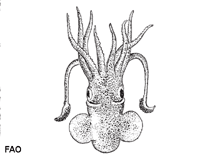Sepiola rondeletii Leach, 1817
Dwarf bobtail squid
رده بندی / Names اسامي عام | مترادف | CoL | ITIS | WoRMS
Cephalopoda | Sepiida | Sepiolidae | Sepiolinae
Environment: milieu / climate zone / تغييرات عمق / distribution range بوم شناسي
; تغييرات عمق 21 - 450 m (مرجع 275), usually ? - 35 m (مرجع 275). Subtropical; 81°N - 12°N, 85°W - 37°E
Distribution كشورها | مناطق سازمان خوار و بار جهاني (FAO) | Ecosystems | ظهور | معرفي
Eastern Atlantic, Mediterranean Sea and the Arctic: from North Sea to Senegal and throughout the Mediterranean. Subtropical to polar.
Length at first maturity / Size / Weight / سن
بلوغ: Lm ? range ? - ? cm Max length : 2.5 cm ML جنس نر / بدون خواص جنسي; (مرجع 1695); 6 cm ML (female)
Life cycle and mating behavior بلوغ | تولید مثل | تخم ریزی | Eggs | Fecundity | Larvae
مآخذ اصلی
مراجع | هماهنگ كننده | همكاران
Wood, J.B. and C.L. Day 1998 CephBase. http://www.cephbase.utmb.edu/. [Accessed 26/01/06]. (مرجع 3722)
وضعيت در فهرست قرمز IUCN
(مرجع 130435: Version 2025-1)
وضعيت از نظر سايتس (مرجع 108899)
CMS (مرجع 116361)
خطر برای انسان ها
استفاده انسانی
ماهي گيري – شيلات: تجاري
| FishSource |
ابزارها
اطلاعات بيشتر
منابع اينترنتي
BHL | BOLD Systems | CISTI | DiscoverLife | FAO(Publication : search) | Fishipedia | GenBank (ژنوم, نوکلئوتيد) | GloBI | Gomexsi | Google Books | Google Scholar | Google | PubMed | Tree of Life | Wikipedia (برو, جستجو) | Zoological Record



